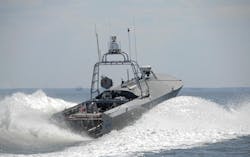Navy eyes advanced minesweeping sensor payload using high-temperature superconducting magnetic materials
ARLINGTON, Va. – U.S. Navy counter-mine warfare researchers are asking the defense industry to develop an advanced minesweeping sensor payload composed of a high-temperature superconducting magnetic source with an advanced acoustic generator for deployment aboard an unmanned mine warfare boat.
Officials of the U.S. Office of Naval Research (ONR) in Arlington, Va. issued a special notice last Friday (N00014-21-S-SN12) for the Magnetic and Acoustic Generation Next Unmanned Superconducting Sweep (MAGNUSS) project.
The advantage of using a high-temperature superconducting magnet in a minesweeping sensor is the ability to run at very high electrical currents with near-zero resistance. The magnet could sweep magnetic influence mines when coupled to an acoustic generator.
ONR has been developing an advanced closed-loop minesweeping system using a high-temperature superconducting magnet coupled with an acoustic source to generate underwater acoustic energy.
Now ONR researchers need industry to integrate the high-temperature superconducting magnet and acoustic generator systems together for deployment aboard the Mine Countermeasure Unmanned Surface Vehicle (MCM-USV) -- a long endurance semi-autonomous diesel-powered aluminum boat that deploys from the Navy's Littoral Combat Ship.
ONR wants to integrate a high-temperature superconducting magnet and a non-towed and low-drag underwater acoustic generator as one payload deployable aboard the MCM- USV.
The Navy has been moving mine countermeasures operations from traditional legacy systems to the Littoral Combat Ship and its MCM-USV.
This effort will involve procurement of a high-temperature superconducting magnet and an acoustic generator; integrating mechanical, electrical, and command and controls (C2) systems; integrating the complete payload with the MCM USV and its hull, mechanical, electrical, and C2 interfaces; testing; and an at-sea demonstration of the payload aboard the MCM-USV.
Related: Navy orders additional unmanned boats from Textron to provide LCS minesweeping capability
Companies interested should email white papers no later than 17 Sept. 2021 to [email protected]. Email full proposals no later than 19 Nov. 2021 to [email protected].
Email technical questions or concerns to the Navy's Brian Almquist, Program Officer, Ocean Battlespace and Expeditionary Access, ONR Code 321, at [email protected]. Email business questions or concerns to Matthew Murray, contracting officer, at [email protected].
More information is online at https://sam.gov/opp/ddd803b6d03e42e9b6dbcde611800317/view.

John Keller | Editor-in-Chief
John Keller is the Editor-in-Chief, Military & Aerospace Electronics Magazine--provides extensive coverage and analysis of enabling electronics and optoelectronic technologies in military, space and commercial aviation applications. John has been a member of the Military & Aerospace Electronics staff since 1989 and chief editor since 1995.

